Exploring Creditor Powers in Corporate Insolvency Under Australian Law
VerifiedAdded on 2023/06/12
|16
|4708
|461
Report
AI Summary
This report provides an analysis of creditor powers in corporate insolvency under Australian law, focusing on the Corporation Act 2001. It defines key terms like 'creditor' and 'corporate insolvency,' outlining the cash-flow and balance sheet tests for determining insolvency. The report discusses various aspects of corporate insolvency, including voluntary administration, liquidation, and receivership, highlighting the powers of secured and unsecured creditors in each scenario. It further examines creditors' rights in deed of company arrangements (DOCA) and their ability to ensure the independence of external administrators. The report emphasizes the legal rights of creditors to claim their money back, challenge decisions, and take action against directors, providing a comprehensive overview of the legal landscape surrounding creditor powers in corporate insolvency.
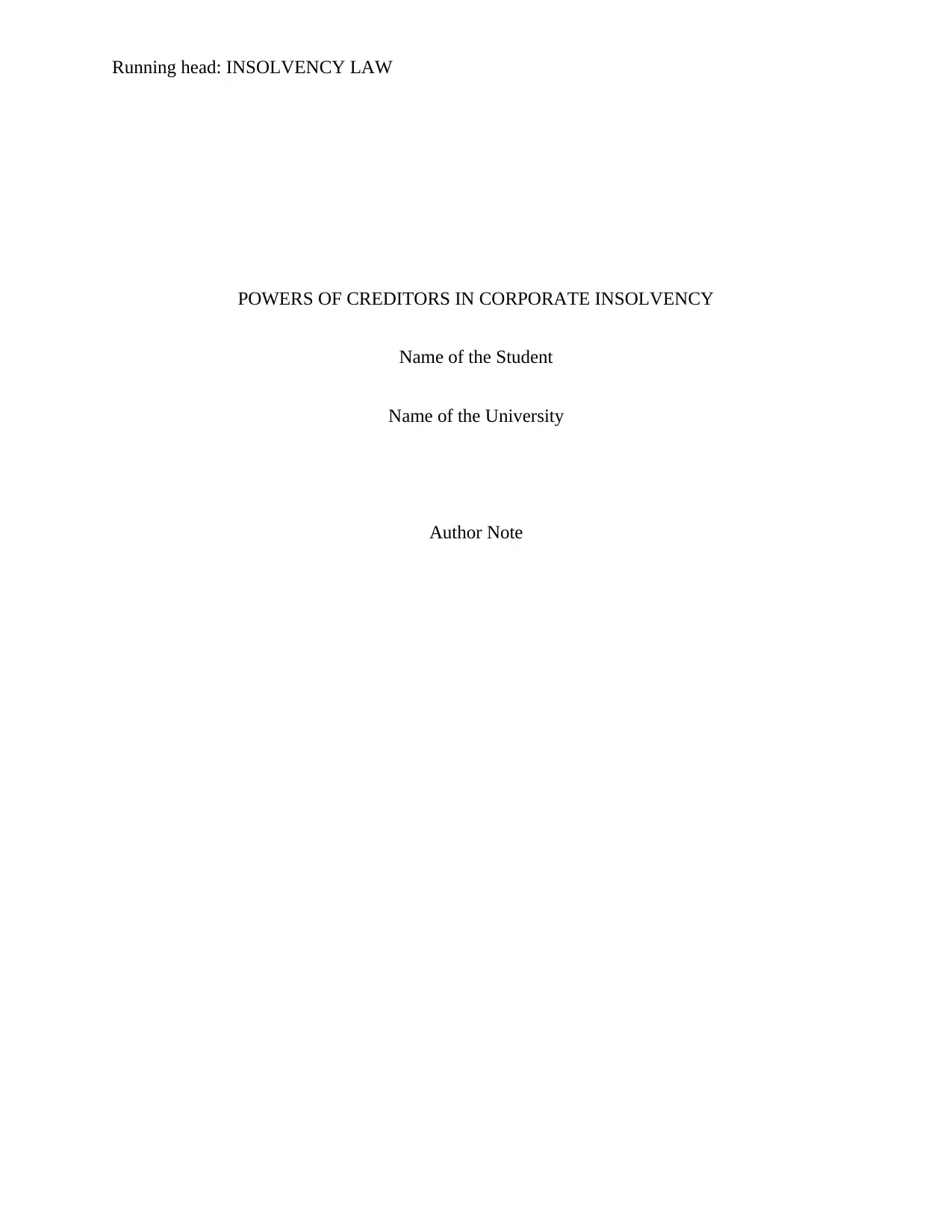
Running head: INSOLVENCY LAW
POWERS OF CREDITORS IN CORPORATE INSOLVENCY
Name of the Student
Name of the University
Author Note
POWERS OF CREDITORS IN CORPORATE INSOLVENCY
Name of the Student
Name of the University
Author Note
Paraphrase This Document
Need a fresh take? Get an instant paraphrase of this document with our AI Paraphraser
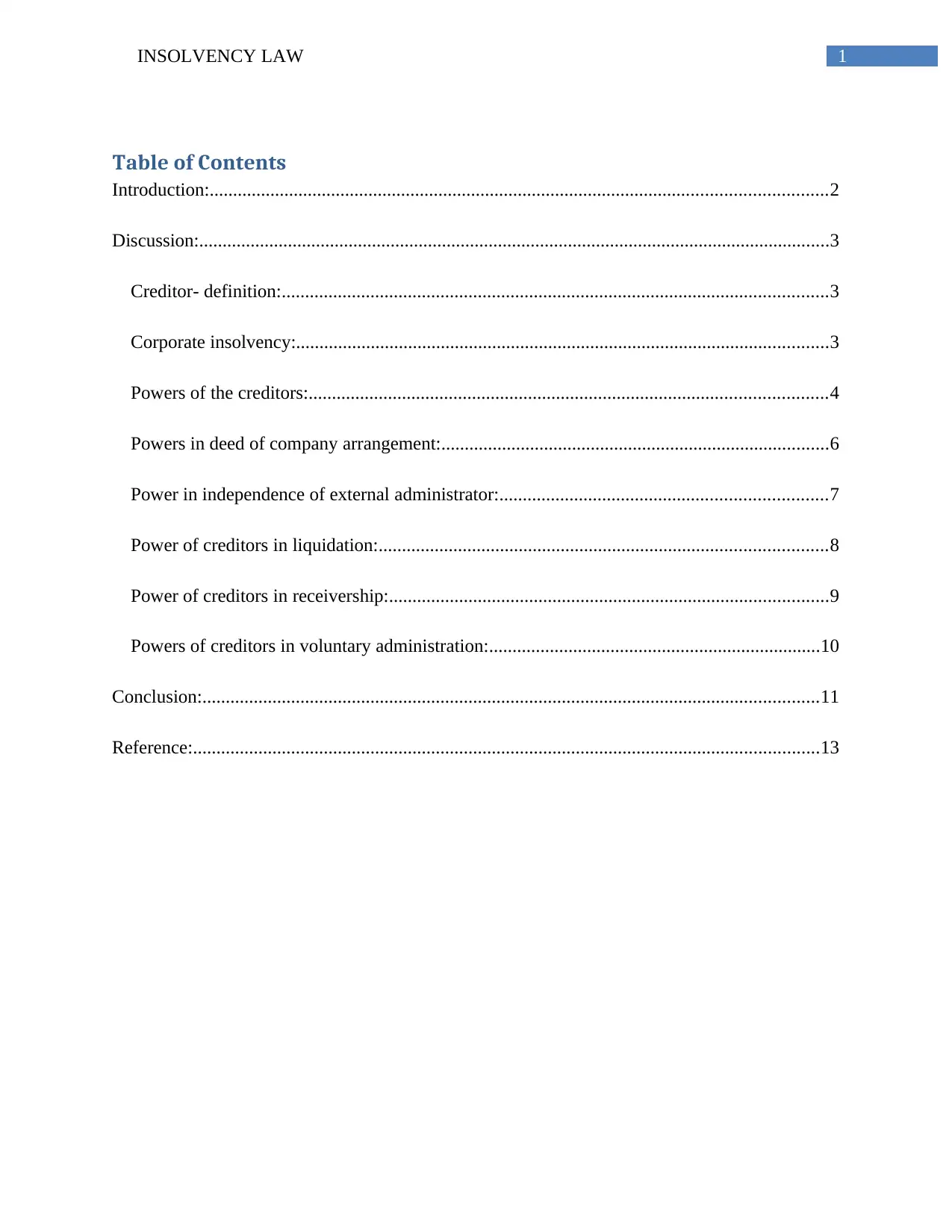
1INSOLVENCY LAW
Table of Contents
Introduction:....................................................................................................................................2
Discussion:.......................................................................................................................................3
Creditor- definition:.....................................................................................................................3
Corporate insolvency:..................................................................................................................3
Powers of the creditors:...............................................................................................................4
Powers in deed of company arrangement:...................................................................................6
Power in independence of external administrator:......................................................................7
Power of creditors in liquidation:................................................................................................8
Power of creditors in receivership:..............................................................................................9
Powers of creditors in voluntary administration:.......................................................................10
Conclusion:....................................................................................................................................11
Reference:......................................................................................................................................13
Table of Contents
Introduction:....................................................................................................................................2
Discussion:.......................................................................................................................................3
Creditor- definition:.....................................................................................................................3
Corporate insolvency:..................................................................................................................3
Powers of the creditors:...............................................................................................................4
Powers in deed of company arrangement:...................................................................................6
Power in independence of external administrator:......................................................................7
Power of creditors in liquidation:................................................................................................8
Power of creditors in receivership:..............................................................................................9
Powers of creditors in voluntary administration:.......................................................................10
Conclusion:....................................................................................................................................11
Reference:......................................................................................................................................13
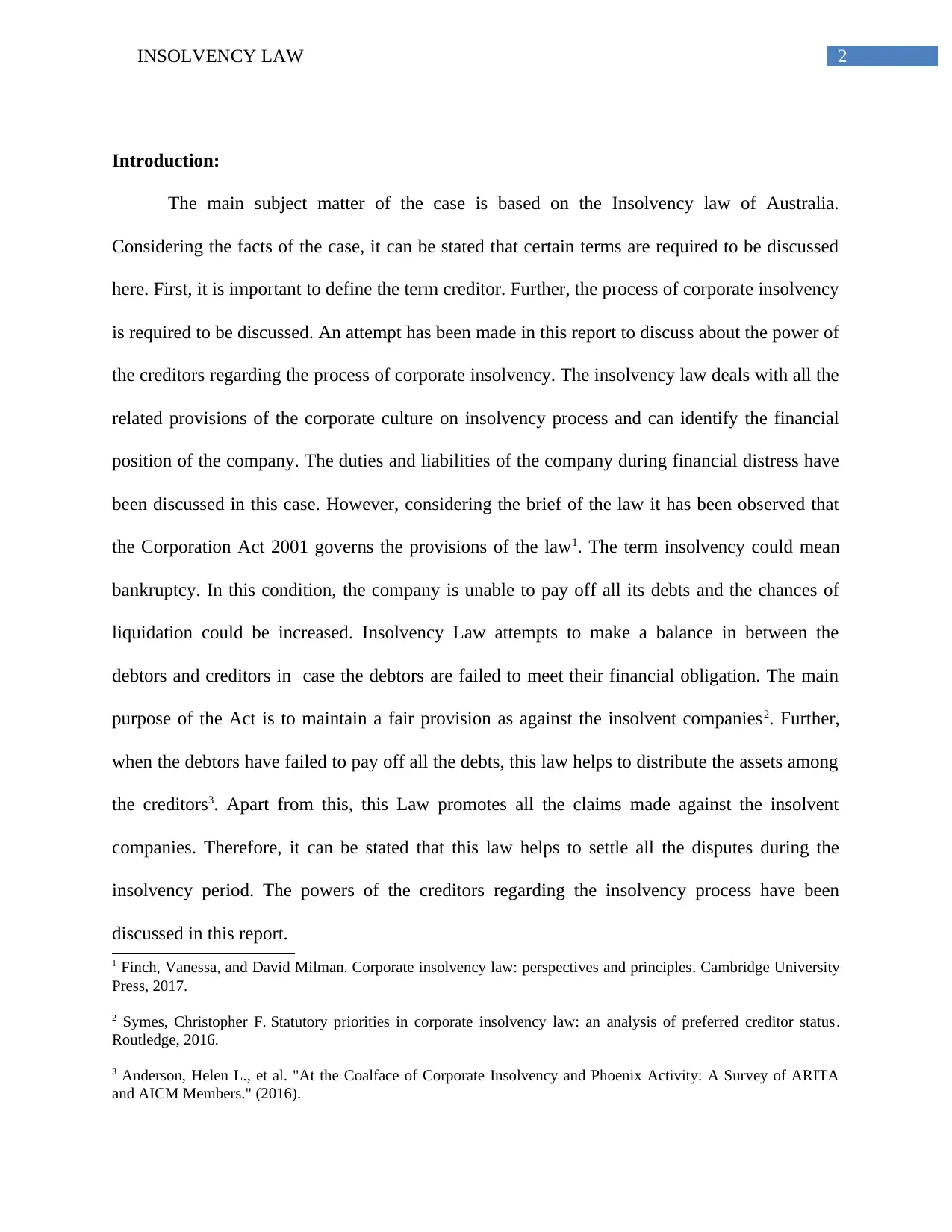
2INSOLVENCY LAW
Introduction:
The main subject matter of the case is based on the Insolvency law of Australia.
Considering the facts of the case, it can be stated that certain terms are required to be discussed
here. First, it is important to define the term creditor. Further, the process of corporate insolvency
is required to be discussed. An attempt has been made in this report to discuss about the power of
the creditors regarding the process of corporate insolvency. The insolvency law deals with all the
related provisions of the corporate culture on insolvency process and can identify the financial
position of the company. The duties and liabilities of the company during financial distress have
been discussed in this case. However, considering the brief of the law it has been observed that
the Corporation Act 2001 governs the provisions of the law1. The term insolvency could mean
bankruptcy. In this condition, the company is unable to pay off all its debts and the chances of
liquidation could be increased. Insolvency Law attempts to make a balance in between the
debtors and creditors in case the debtors are failed to meet their financial obligation. The main
purpose of the Act is to maintain a fair provision as against the insolvent companies2. Further,
when the debtors have failed to pay off all the debts, this law helps to distribute the assets among
the creditors3. Apart from this, this Law promotes all the claims made against the insolvent
companies. Therefore, it can be stated that this law helps to settle all the disputes during the
insolvency period. The powers of the creditors regarding the insolvency process have been
discussed in this report.
1 Finch, Vanessa, and David Milman. Corporate insolvency law: perspectives and principles. Cambridge University
Press, 2017.
2 Symes, Christopher F. Statutory priorities in corporate insolvency law: an analysis of preferred creditor status.
Routledge, 2016.
3 Anderson, Helen L., et al. "At the Coalface of Corporate Insolvency and Phoenix Activity: A Survey of ARITA
and AICM Members." (2016).
Introduction:
The main subject matter of the case is based on the Insolvency law of Australia.
Considering the facts of the case, it can be stated that certain terms are required to be discussed
here. First, it is important to define the term creditor. Further, the process of corporate insolvency
is required to be discussed. An attempt has been made in this report to discuss about the power of
the creditors regarding the process of corporate insolvency. The insolvency law deals with all the
related provisions of the corporate culture on insolvency process and can identify the financial
position of the company. The duties and liabilities of the company during financial distress have
been discussed in this case. However, considering the brief of the law it has been observed that
the Corporation Act 2001 governs the provisions of the law1. The term insolvency could mean
bankruptcy. In this condition, the company is unable to pay off all its debts and the chances of
liquidation could be increased. Insolvency Law attempts to make a balance in between the
debtors and creditors in case the debtors are failed to meet their financial obligation. The main
purpose of the Act is to maintain a fair provision as against the insolvent companies2. Further,
when the debtors have failed to pay off all the debts, this law helps to distribute the assets among
the creditors3. Apart from this, this Law promotes all the claims made against the insolvent
companies. Therefore, it can be stated that this law helps to settle all the disputes during the
insolvency period. The powers of the creditors regarding the insolvency process have been
discussed in this report.
1 Finch, Vanessa, and David Milman. Corporate insolvency law: perspectives and principles. Cambridge University
Press, 2017.
2 Symes, Christopher F. Statutory priorities in corporate insolvency law: an analysis of preferred creditor status.
Routledge, 2016.
3 Anderson, Helen L., et al. "At the Coalface of Corporate Insolvency and Phoenix Activity: A Survey of ARITA
and AICM Members." (2016).
⊘ This is a preview!⊘
Do you want full access?
Subscribe today to unlock all pages.

Trusted by 1+ million students worldwide
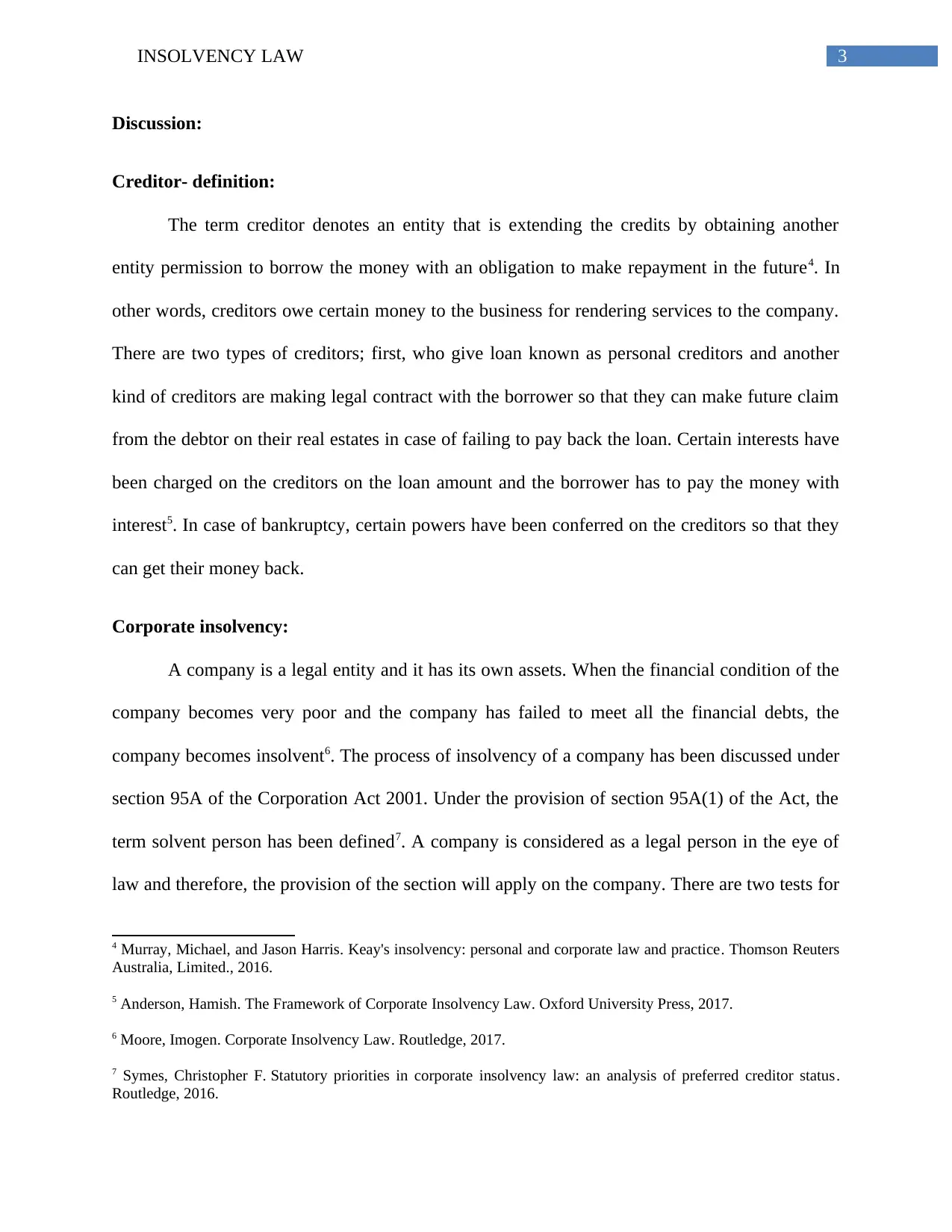
3INSOLVENCY LAW
Discussion:
Creditor- definition:
The term creditor denotes an entity that is extending the credits by obtaining another
entity permission to borrow the money with an obligation to make repayment in the future4. In
other words, creditors owe certain money to the business for rendering services to the company.
There are two types of creditors; first, who give loan known as personal creditors and another
kind of creditors are making legal contract with the borrower so that they can make future claim
from the debtor on their real estates in case of failing to pay back the loan. Certain interests have
been charged on the creditors on the loan amount and the borrower has to pay the money with
interest5. In case of bankruptcy, certain powers have been conferred on the creditors so that they
can get their money back.
Corporate insolvency:
A company is a legal entity and it has its own assets. When the financial condition of the
company becomes very poor and the company has failed to meet all the financial debts, the
company becomes insolvent6. The process of insolvency of a company has been discussed under
section 95A of the Corporation Act 2001. Under the provision of section 95A(1) of the Act, the
term solvent person has been defined7. A company is considered as a legal person in the eye of
law and therefore, the provision of the section will apply on the company. There are two tests for
4 Murray, Michael, and Jason Harris. Keay's insolvency: personal and corporate law and practice. Thomson Reuters
Australia, Limited., 2016.
5 Anderson, Hamish. The Framework of Corporate Insolvency Law. Oxford University Press, 2017.
6 Moore, Imogen. Corporate Insolvency Law. Routledge, 2017.
7 Symes, Christopher F. Statutory priorities in corporate insolvency law: an analysis of preferred creditor status.
Routledge, 2016.
Discussion:
Creditor- definition:
The term creditor denotes an entity that is extending the credits by obtaining another
entity permission to borrow the money with an obligation to make repayment in the future4. In
other words, creditors owe certain money to the business for rendering services to the company.
There are two types of creditors; first, who give loan known as personal creditors and another
kind of creditors are making legal contract with the borrower so that they can make future claim
from the debtor on their real estates in case of failing to pay back the loan. Certain interests have
been charged on the creditors on the loan amount and the borrower has to pay the money with
interest5. In case of bankruptcy, certain powers have been conferred on the creditors so that they
can get their money back.
Corporate insolvency:
A company is a legal entity and it has its own assets. When the financial condition of the
company becomes very poor and the company has failed to meet all the financial debts, the
company becomes insolvent6. The process of insolvency of a company has been discussed under
section 95A of the Corporation Act 2001. Under the provision of section 95A(1) of the Act, the
term solvent person has been defined7. A company is considered as a legal person in the eye of
law and therefore, the provision of the section will apply on the company. There are two tests for
4 Murray, Michael, and Jason Harris. Keay's insolvency: personal and corporate law and practice. Thomson Reuters
Australia, Limited., 2016.
5 Anderson, Hamish. The Framework of Corporate Insolvency Law. Oxford University Press, 2017.
6 Moore, Imogen. Corporate Insolvency Law. Routledge, 2017.
7 Symes, Christopher F. Statutory priorities in corporate insolvency law: an analysis of preferred creditor status.
Routledge, 2016.
Paraphrase This Document
Need a fresh take? Get an instant paraphrase of this document with our AI Paraphraser
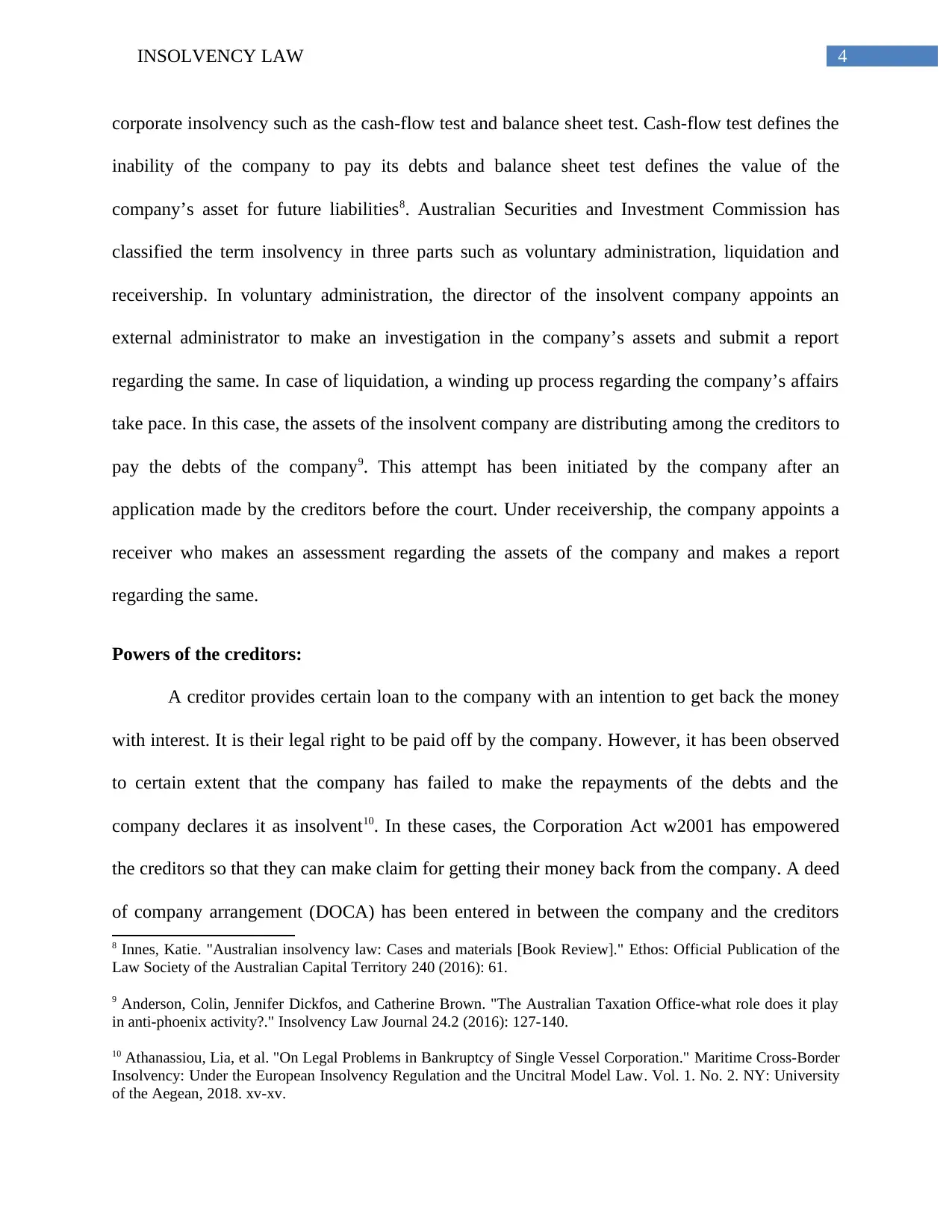
4INSOLVENCY LAW
corporate insolvency such as the cash-flow test and balance sheet test. Cash-flow test defines the
inability of the company to pay its debts and balance sheet test defines the value of the
company’s asset for future liabilities8. Australian Securities and Investment Commission has
classified the term insolvency in three parts such as voluntary administration, liquidation and
receivership. In voluntary administration, the director of the insolvent company appoints an
external administrator to make an investigation in the company’s assets and submit a report
regarding the same. In case of liquidation, a winding up process regarding the company’s affairs
take pace. In this case, the assets of the insolvent company are distributing among the creditors to
pay the debts of the company9. This attempt has been initiated by the company after an
application made by the creditors before the court. Under receivership, the company appoints a
receiver who makes an assessment regarding the assets of the company and makes a report
regarding the same.
Powers of the creditors:
A creditor provides certain loan to the company with an intention to get back the money
with interest. It is their legal right to be paid off by the company. However, it has been observed
to certain extent that the company has failed to make the repayments of the debts and the
company declares it as insolvent10. In these cases, the Corporation Act w2001 has empowered
the creditors so that they can make claim for getting their money back from the company. A deed
of company arrangement (DOCA) has been entered in between the company and the creditors
8 Innes, Katie. "Australian insolvency law: Cases and materials [Book Review]." Ethos: Official Publication of the
Law Society of the Australian Capital Territory 240 (2016): 61.
9 Anderson, Colin, Jennifer Dickfos, and Catherine Brown. "The Australian Taxation Office-what role does it play
in anti-phoenix activity?." Insolvency Law Journal 24.2 (2016): 127-140.
10 Athanassiou, Lia, et al. "On Legal Problems in Bankruptcy of Single Vessel Corporation." Maritime Cross-Border
Insolvency: Under the European Insolvency Regulation and the Uncitral Model Law. Vol. 1. No. 2. NY: University
of the Aegean, 2018. xv-xv.
corporate insolvency such as the cash-flow test and balance sheet test. Cash-flow test defines the
inability of the company to pay its debts and balance sheet test defines the value of the
company’s asset for future liabilities8. Australian Securities and Investment Commission has
classified the term insolvency in three parts such as voluntary administration, liquidation and
receivership. In voluntary administration, the director of the insolvent company appoints an
external administrator to make an investigation in the company’s assets and submit a report
regarding the same. In case of liquidation, a winding up process regarding the company’s affairs
take pace. In this case, the assets of the insolvent company are distributing among the creditors to
pay the debts of the company9. This attempt has been initiated by the company after an
application made by the creditors before the court. Under receivership, the company appoints a
receiver who makes an assessment regarding the assets of the company and makes a report
regarding the same.
Powers of the creditors:
A creditor provides certain loan to the company with an intention to get back the money
with interest. It is their legal right to be paid off by the company. However, it has been observed
to certain extent that the company has failed to make the repayments of the debts and the
company declares it as insolvent10. In these cases, the Corporation Act w2001 has empowered
the creditors so that they can make claim for getting their money back from the company. A deed
of company arrangement (DOCA) has been entered in between the company and the creditors
8 Innes, Katie. "Australian insolvency law: Cases and materials [Book Review]." Ethos: Official Publication of the
Law Society of the Australian Capital Territory 240 (2016): 61.
9 Anderson, Colin, Jennifer Dickfos, and Catherine Brown. "The Australian Taxation Office-what role does it play
in anti-phoenix activity?." Insolvency Law Journal 24.2 (2016): 127-140.
10 Athanassiou, Lia, et al. "On Legal Problems in Bankruptcy of Single Vessel Corporation." Maritime Cross-Border
Insolvency: Under the European Insolvency Regulation and the Uncitral Model Law. Vol. 1. No. 2. NY: University
of the Aegean, 2018. xv-xv.
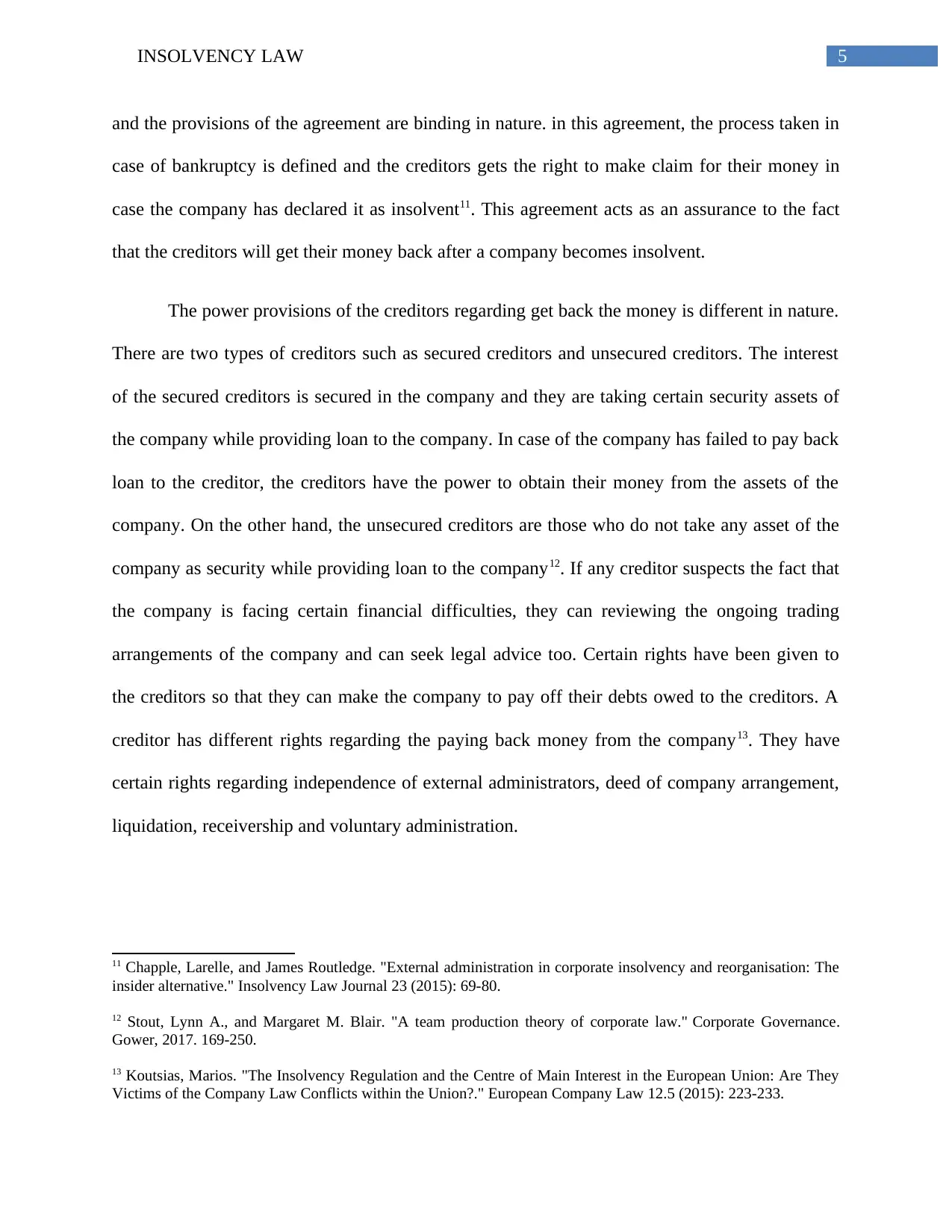
5INSOLVENCY LAW
and the provisions of the agreement are binding in nature. in this agreement, the process taken in
case of bankruptcy is defined and the creditors gets the right to make claim for their money in
case the company has declared it as insolvent11. This agreement acts as an assurance to the fact
that the creditors will get their money back after a company becomes insolvent.
The power provisions of the creditors regarding get back the money is different in nature.
There are two types of creditors such as secured creditors and unsecured creditors. The interest
of the secured creditors is secured in the company and they are taking certain security assets of
the company while providing loan to the company. In case of the company has failed to pay back
loan to the creditor, the creditors have the power to obtain their money from the assets of the
company. On the other hand, the unsecured creditors are those who do not take any asset of the
company as security while providing loan to the company12. If any creditor suspects the fact that
the company is facing certain financial difficulties, they can reviewing the ongoing trading
arrangements of the company and can seek legal advice too. Certain rights have been given to
the creditors so that they can make the company to pay off their debts owed to the creditors. A
creditor has different rights regarding the paying back money from the company13. They have
certain rights regarding independence of external administrators, deed of company arrangement,
liquidation, receivership and voluntary administration.
11 Chapple, Larelle, and James Routledge. "External administration in corporate insolvency and reorganisation: The
insider alternative." Insolvency Law Journal 23 (2015): 69-80.
12 Stout, Lynn A., and Margaret M. Blair. "A team production theory of corporate law." Corporate Governance.
Gower, 2017. 169-250.
13 Koutsias, Marios. "The Insolvency Regulation and the Centre of Main Interest in the European Union: Are They
Victims of the Company Law Conflicts within the Union?." European Company Law 12.5 (2015): 223-233.
and the provisions of the agreement are binding in nature. in this agreement, the process taken in
case of bankruptcy is defined and the creditors gets the right to make claim for their money in
case the company has declared it as insolvent11. This agreement acts as an assurance to the fact
that the creditors will get their money back after a company becomes insolvent.
The power provisions of the creditors regarding get back the money is different in nature.
There are two types of creditors such as secured creditors and unsecured creditors. The interest
of the secured creditors is secured in the company and they are taking certain security assets of
the company while providing loan to the company. In case of the company has failed to pay back
loan to the creditor, the creditors have the power to obtain their money from the assets of the
company. On the other hand, the unsecured creditors are those who do not take any asset of the
company as security while providing loan to the company12. If any creditor suspects the fact that
the company is facing certain financial difficulties, they can reviewing the ongoing trading
arrangements of the company and can seek legal advice too. Certain rights have been given to
the creditors so that they can make the company to pay off their debts owed to the creditors. A
creditor has different rights regarding the paying back money from the company13. They have
certain rights regarding independence of external administrators, deed of company arrangement,
liquidation, receivership and voluntary administration.
11 Chapple, Larelle, and James Routledge. "External administration in corporate insolvency and reorganisation: The
insider alternative." Insolvency Law Journal 23 (2015): 69-80.
12 Stout, Lynn A., and Margaret M. Blair. "A team production theory of corporate law." Corporate Governance.
Gower, 2017. 169-250.
13 Koutsias, Marios. "The Insolvency Regulation and the Centre of Main Interest in the European Union: Are They
Victims of the Company Law Conflicts within the Union?." European Company Law 12.5 (2015): 223-233.
⊘ This is a preview!⊘
Do you want full access?
Subscribe today to unlock all pages.

Trusted by 1+ million students worldwide
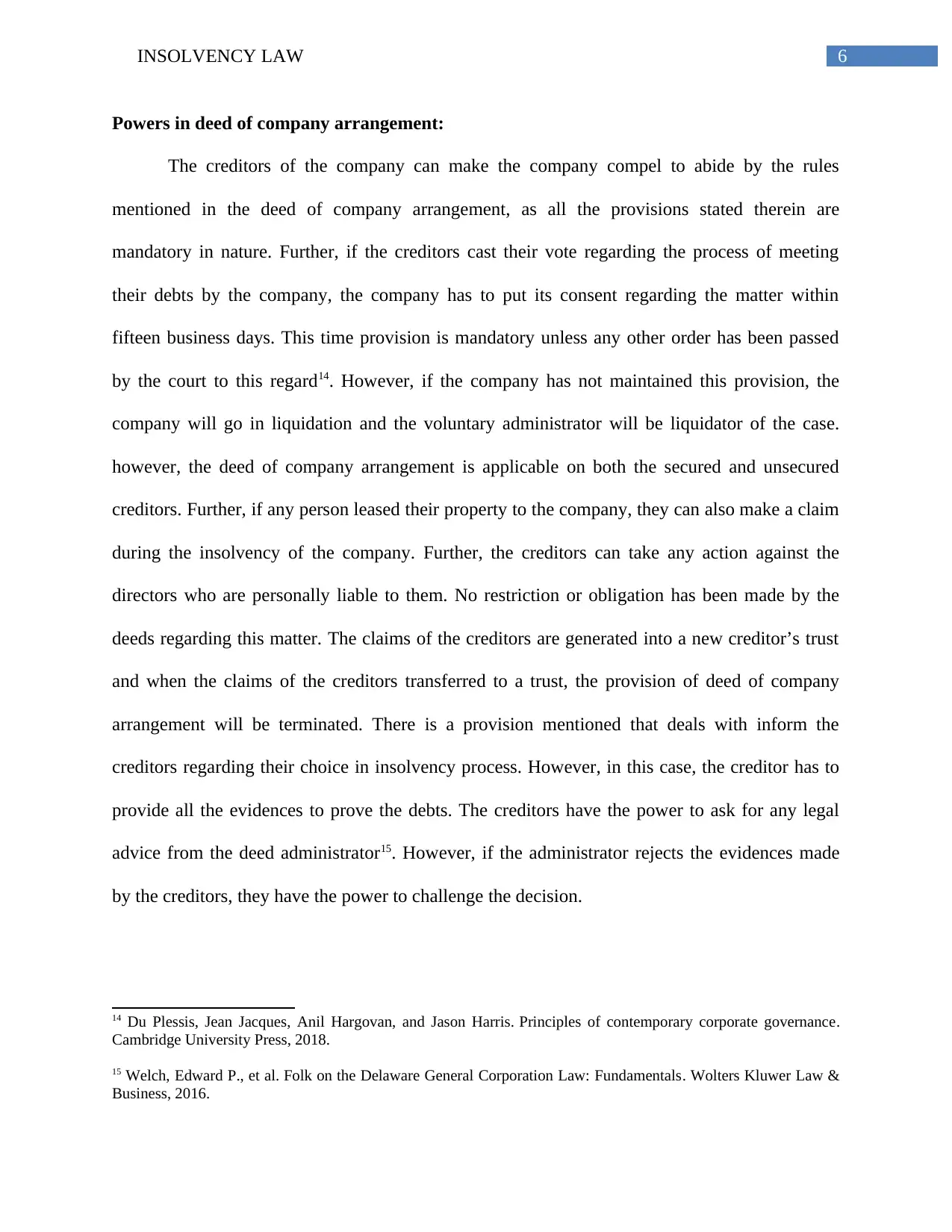
6INSOLVENCY LAW
Powers in deed of company arrangement:
The creditors of the company can make the company compel to abide by the rules
mentioned in the deed of company arrangement, as all the provisions stated therein are
mandatory in nature. Further, if the creditors cast their vote regarding the process of meeting
their debts by the company, the company has to put its consent regarding the matter within
fifteen business days. This time provision is mandatory unless any other order has been passed
by the court to this regard14. However, if the company has not maintained this provision, the
company will go in liquidation and the voluntary administrator will be liquidator of the case.
however, the deed of company arrangement is applicable on both the secured and unsecured
creditors. Further, if any person leased their property to the company, they can also make a claim
during the insolvency of the company. Further, the creditors can take any action against the
directors who are personally liable to them. No restriction or obligation has been made by the
deeds regarding this matter. The claims of the creditors are generated into a new creditor’s trust
and when the claims of the creditors transferred to a trust, the provision of deed of company
arrangement will be terminated. There is a provision mentioned that deals with inform the
creditors regarding their choice in insolvency process. However, in this case, the creditor has to
provide all the evidences to prove the debts. The creditors have the power to ask for any legal
advice from the deed administrator15. However, if the administrator rejects the evidences made
by the creditors, they have the power to challenge the decision.
14 Du Plessis, Jean Jacques, Anil Hargovan, and Jason Harris. Principles of contemporary corporate governance.
Cambridge University Press, 2018.
15 Welch, Edward P., et al. Folk on the Delaware General Corporation Law: Fundamentals. Wolters Kluwer Law &
Business, 2016.
Powers in deed of company arrangement:
The creditors of the company can make the company compel to abide by the rules
mentioned in the deed of company arrangement, as all the provisions stated therein are
mandatory in nature. Further, if the creditors cast their vote regarding the process of meeting
their debts by the company, the company has to put its consent regarding the matter within
fifteen business days. This time provision is mandatory unless any other order has been passed
by the court to this regard14. However, if the company has not maintained this provision, the
company will go in liquidation and the voluntary administrator will be liquidator of the case.
however, the deed of company arrangement is applicable on both the secured and unsecured
creditors. Further, if any person leased their property to the company, they can also make a claim
during the insolvency of the company. Further, the creditors can take any action against the
directors who are personally liable to them. No restriction or obligation has been made by the
deeds regarding this matter. The claims of the creditors are generated into a new creditor’s trust
and when the claims of the creditors transferred to a trust, the provision of deed of company
arrangement will be terminated. There is a provision mentioned that deals with inform the
creditors regarding their choice in insolvency process. However, in this case, the creditor has to
provide all the evidences to prove the debts. The creditors have the power to ask for any legal
advice from the deed administrator15. However, if the administrator rejects the evidences made
by the creditors, they have the power to challenge the decision.
14 Du Plessis, Jean Jacques, Anil Hargovan, and Jason Harris. Principles of contemporary corporate governance.
Cambridge University Press, 2018.
15 Welch, Edward P., et al. Folk on the Delaware General Corporation Law: Fundamentals. Wolters Kluwer Law &
Business, 2016.
Paraphrase This Document
Need a fresh take? Get an instant paraphrase of this document with our AI Paraphraser
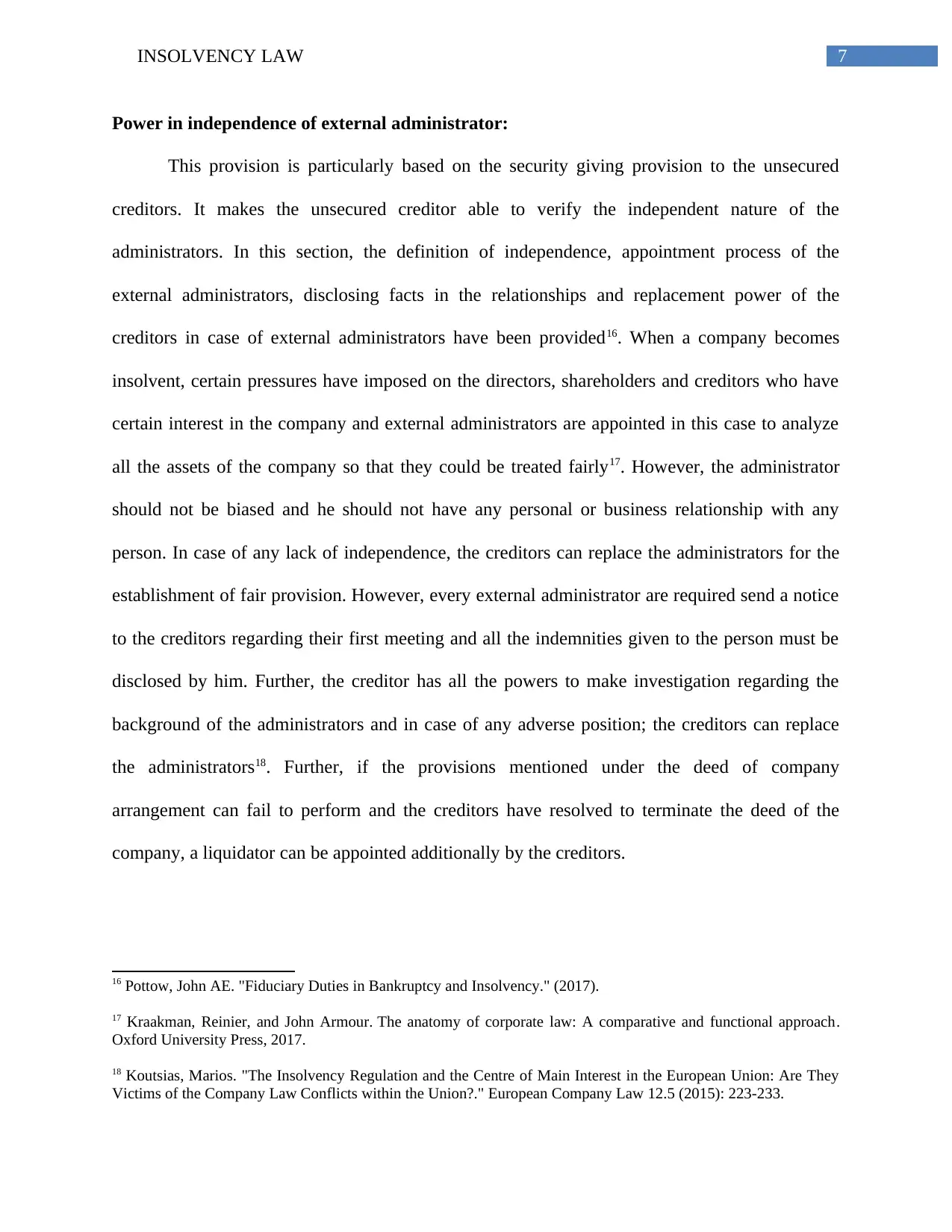
7INSOLVENCY LAW
Power in independence of external administrator:
This provision is particularly based on the security giving provision to the unsecured
creditors. It makes the unsecured creditor able to verify the independent nature of the
administrators. In this section, the definition of independence, appointment process of the
external administrators, disclosing facts in the relationships and replacement power of the
creditors in case of external administrators have been provided16. When a company becomes
insolvent, certain pressures have imposed on the directors, shareholders and creditors who have
certain interest in the company and external administrators are appointed in this case to analyze
all the assets of the company so that they could be treated fairly17. However, the administrator
should not be biased and he should not have any personal or business relationship with any
person. In case of any lack of independence, the creditors can replace the administrators for the
establishment of fair provision. However, every external administrator are required send a notice
to the creditors regarding their first meeting and all the indemnities given to the person must be
disclosed by him. Further, the creditor has all the powers to make investigation regarding the
background of the administrators and in case of any adverse position; the creditors can replace
the administrators18. Further, if the provisions mentioned under the deed of company
arrangement can fail to perform and the creditors have resolved to terminate the deed of the
company, a liquidator can be appointed additionally by the creditors.
16 Pottow, John AE. "Fiduciary Duties in Bankruptcy and Insolvency." (2017).
17 Kraakman, Reinier, and John Armour. The anatomy of corporate law: A comparative and functional approach.
Oxford University Press, 2017.
18 Koutsias, Marios. "The Insolvency Regulation and the Centre of Main Interest in the European Union: Are They
Victims of the Company Law Conflicts within the Union?." European Company Law 12.5 (2015): 223-233.
Power in independence of external administrator:
This provision is particularly based on the security giving provision to the unsecured
creditors. It makes the unsecured creditor able to verify the independent nature of the
administrators. In this section, the definition of independence, appointment process of the
external administrators, disclosing facts in the relationships and replacement power of the
creditors in case of external administrators have been provided16. When a company becomes
insolvent, certain pressures have imposed on the directors, shareholders and creditors who have
certain interest in the company and external administrators are appointed in this case to analyze
all the assets of the company so that they could be treated fairly17. However, the administrator
should not be biased and he should not have any personal or business relationship with any
person. In case of any lack of independence, the creditors can replace the administrators for the
establishment of fair provision. However, every external administrator are required send a notice
to the creditors regarding their first meeting and all the indemnities given to the person must be
disclosed by him. Further, the creditor has all the powers to make investigation regarding the
background of the administrators and in case of any adverse position; the creditors can replace
the administrators18. Further, if the provisions mentioned under the deed of company
arrangement can fail to perform and the creditors have resolved to terminate the deed of the
company, a liquidator can be appointed additionally by the creditors.
16 Pottow, John AE. "Fiduciary Duties in Bankruptcy and Insolvency." (2017).
17 Kraakman, Reinier, and John Armour. The anatomy of corporate law: A comparative and functional approach.
Oxford University Press, 2017.
18 Koutsias, Marios. "The Insolvency Regulation and the Centre of Main Interest in the European Union: Are They
Victims of the Company Law Conflicts within the Union?." European Company Law 12.5 (2015): 223-233.
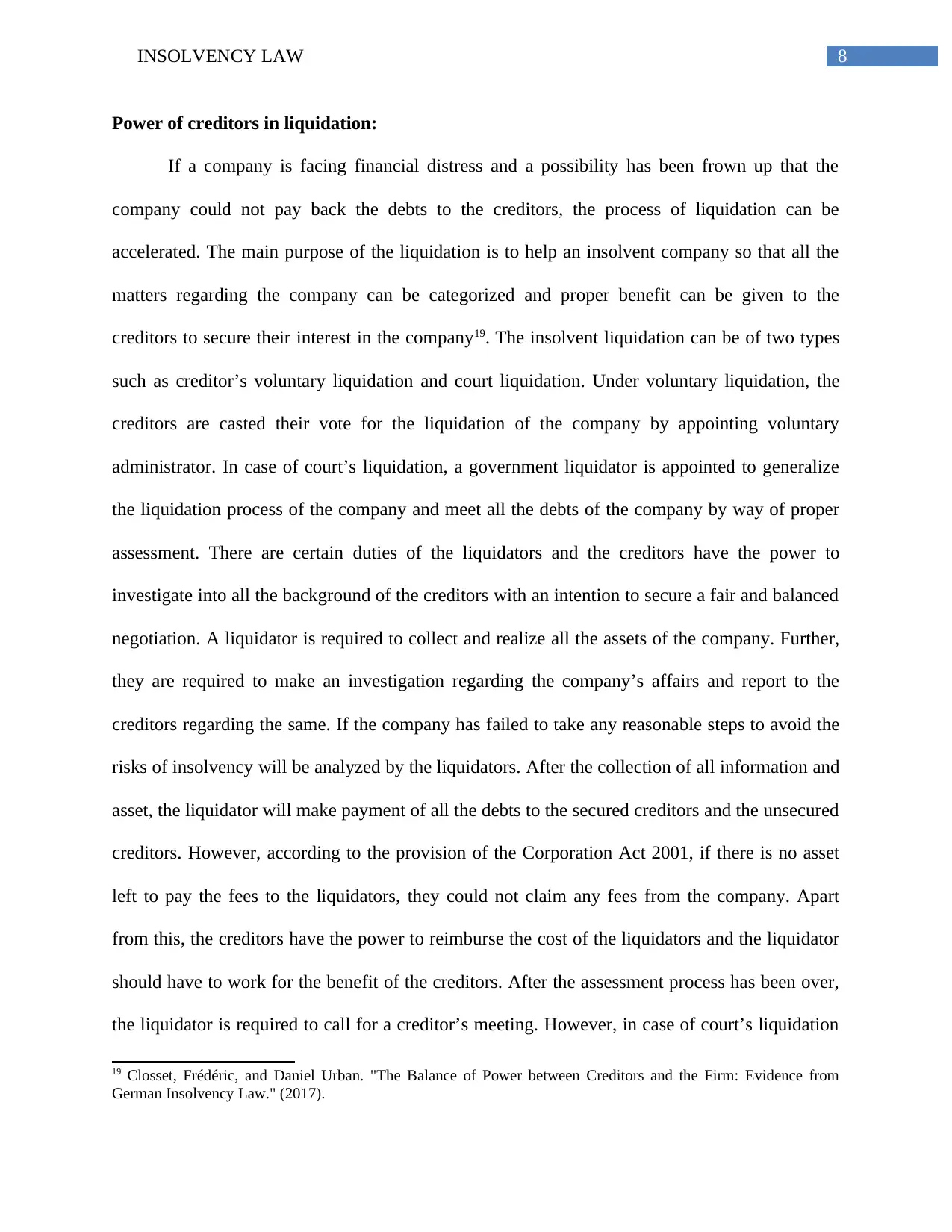
8INSOLVENCY LAW
Power of creditors in liquidation:
If a company is facing financial distress and a possibility has been frown up that the
company could not pay back the debts to the creditors, the process of liquidation can be
accelerated. The main purpose of the liquidation is to help an insolvent company so that all the
matters regarding the company can be categorized and proper benefit can be given to the
creditors to secure their interest in the company19. The insolvent liquidation can be of two types
such as creditor’s voluntary liquidation and court liquidation. Under voluntary liquidation, the
creditors are casted their vote for the liquidation of the company by appointing voluntary
administrator. In case of court’s liquidation, a government liquidator is appointed to generalize
the liquidation process of the company and meet all the debts of the company by way of proper
assessment. There are certain duties of the liquidators and the creditors have the power to
investigate into all the background of the creditors with an intention to secure a fair and balanced
negotiation. A liquidator is required to collect and realize all the assets of the company. Further,
they are required to make an investigation regarding the company’s affairs and report to the
creditors regarding the same. If the company has failed to take any reasonable steps to avoid the
risks of insolvency will be analyzed by the liquidators. After the collection of all information and
asset, the liquidator will make payment of all the debts to the secured creditors and the unsecured
creditors. However, according to the provision of the Corporation Act 2001, if there is no asset
left to pay the fees to the liquidators, they could not claim any fees from the company. Apart
from this, the creditors have the power to reimburse the cost of the liquidators and the liquidator
should have to work for the benefit of the creditors. After the assessment process has been over,
the liquidator is required to call for a creditor’s meeting. However, in case of court’s liquidation
19 Closset, Frédéric, and Daniel Urban. "The Balance of Power between Creditors and the Firm: Evidence from
German Insolvency Law." (2017).
Power of creditors in liquidation:
If a company is facing financial distress and a possibility has been frown up that the
company could not pay back the debts to the creditors, the process of liquidation can be
accelerated. The main purpose of the liquidation is to help an insolvent company so that all the
matters regarding the company can be categorized and proper benefit can be given to the
creditors to secure their interest in the company19. The insolvent liquidation can be of two types
such as creditor’s voluntary liquidation and court liquidation. Under voluntary liquidation, the
creditors are casted their vote for the liquidation of the company by appointing voluntary
administrator. In case of court’s liquidation, a government liquidator is appointed to generalize
the liquidation process of the company and meet all the debts of the company by way of proper
assessment. There are certain duties of the liquidators and the creditors have the power to
investigate into all the background of the creditors with an intention to secure a fair and balanced
negotiation. A liquidator is required to collect and realize all the assets of the company. Further,
they are required to make an investigation regarding the company’s affairs and report to the
creditors regarding the same. If the company has failed to take any reasonable steps to avoid the
risks of insolvency will be analyzed by the liquidators. After the collection of all information and
asset, the liquidator will make payment of all the debts to the secured creditors and the unsecured
creditors. However, according to the provision of the Corporation Act 2001, if there is no asset
left to pay the fees to the liquidators, they could not claim any fees from the company. Apart
from this, the creditors have the power to reimburse the cost of the liquidators and the liquidator
should have to work for the benefit of the creditors. After the assessment process has been over,
the liquidator is required to call for a creditor’s meeting. However, in case of court’s liquidation
19 Closset, Frédéric, and Daniel Urban. "The Balance of Power between Creditors and the Firm: Evidence from
German Insolvency Law." (2017).
⊘ This is a preview!⊘
Do you want full access?
Subscribe today to unlock all pages.

Trusted by 1+ million students worldwide
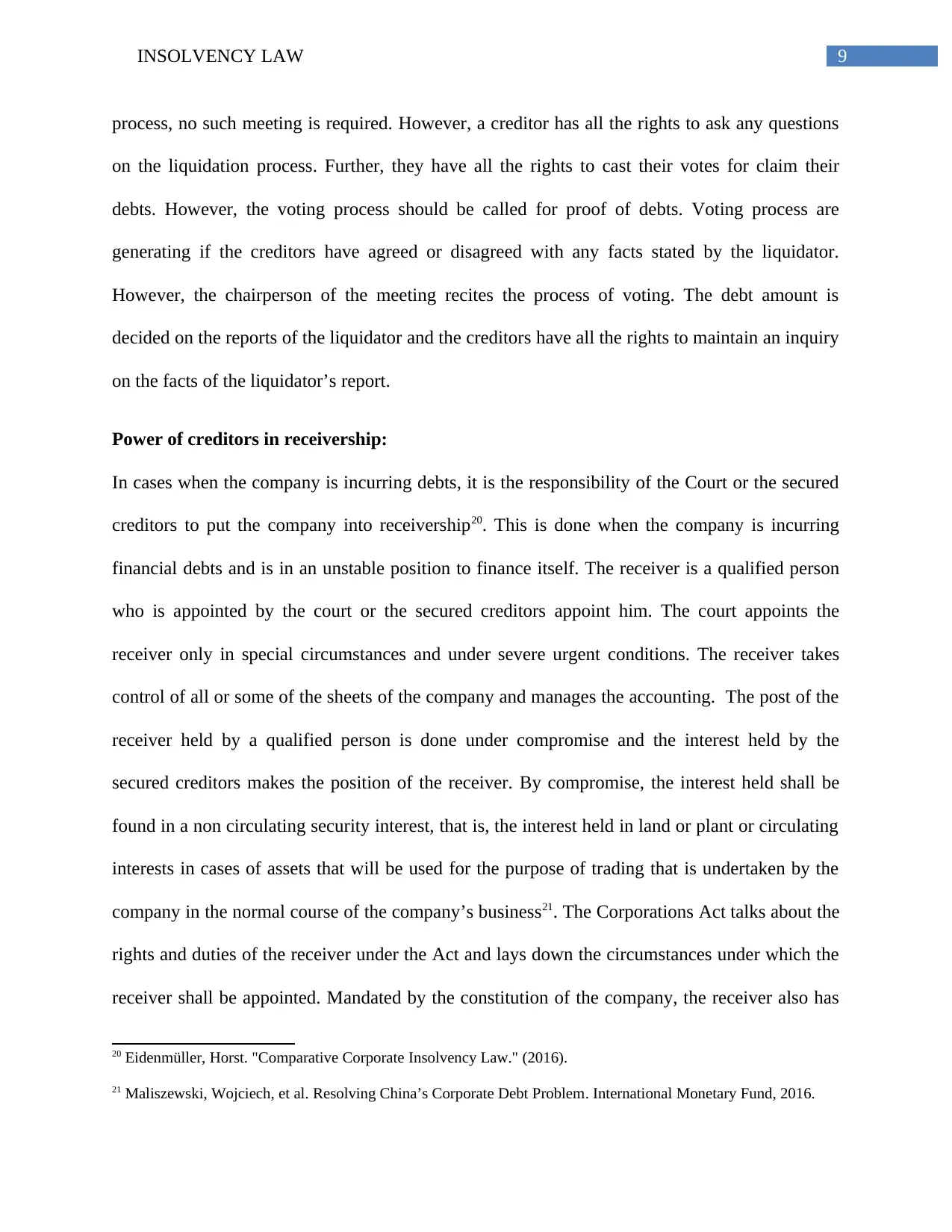
9INSOLVENCY LAW
process, no such meeting is required. However, a creditor has all the rights to ask any questions
on the liquidation process. Further, they have all the rights to cast their votes for claim their
debts. However, the voting process should be called for proof of debts. Voting process are
generating if the creditors have agreed or disagreed with any facts stated by the liquidator.
However, the chairperson of the meeting recites the process of voting. The debt amount is
decided on the reports of the liquidator and the creditors have all the rights to maintain an inquiry
on the facts of the liquidator’s report.
Power of creditors in receivership:
In cases when the company is incurring debts, it is the responsibility of the Court or the secured
creditors to put the company into receivership20. This is done when the company is incurring
financial debts and is in an unstable position to finance itself. The receiver is a qualified person
who is appointed by the court or the secured creditors appoint him. The court appoints the
receiver only in special circumstances and under severe urgent conditions. The receiver takes
control of all or some of the sheets of the company and manages the accounting. The post of the
receiver held by a qualified person is done under compromise and the interest held by the
secured creditors makes the position of the receiver. By compromise, the interest held shall be
found in a non circulating security interest, that is, the interest held in land or plant or circulating
interests in cases of assets that will be used for the purpose of trading that is undertaken by the
company in the normal course of the company’s business21. The Corporations Act talks about the
rights and duties of the receiver under the Act and lays down the circumstances under which the
receiver shall be appointed. Mandated by the constitution of the company, the receiver also has
20 Eidenmüller, Horst. "Comparative Corporate Insolvency Law." (2016).
21 Maliszewski, Wojciech, et al. Resolving China’s Corporate Debt Problem. International Monetary Fund, 2016.
process, no such meeting is required. However, a creditor has all the rights to ask any questions
on the liquidation process. Further, they have all the rights to cast their votes for claim their
debts. However, the voting process should be called for proof of debts. Voting process are
generating if the creditors have agreed or disagreed with any facts stated by the liquidator.
However, the chairperson of the meeting recites the process of voting. The debt amount is
decided on the reports of the liquidator and the creditors have all the rights to maintain an inquiry
on the facts of the liquidator’s report.
Power of creditors in receivership:
In cases when the company is incurring debts, it is the responsibility of the Court or the secured
creditors to put the company into receivership20. This is done when the company is incurring
financial debts and is in an unstable position to finance itself. The receiver is a qualified person
who is appointed by the court or the secured creditors appoint him. The court appoints the
receiver only in special circumstances and under severe urgent conditions. The receiver takes
control of all or some of the sheets of the company and manages the accounting. The post of the
receiver held by a qualified person is done under compromise and the interest held by the
secured creditors makes the position of the receiver. By compromise, the interest held shall be
found in a non circulating security interest, that is, the interest held in land or plant or circulating
interests in cases of assets that will be used for the purpose of trading that is undertaken by the
company in the normal course of the company’s business21. The Corporations Act talks about the
rights and duties of the receiver under the Act and lays down the circumstances under which the
receiver shall be appointed. Mandated by the constitution of the company, the receiver also has
20 Eidenmüller, Horst. "Comparative Corporate Insolvency Law." (2016).
21 Maliszewski, Wojciech, et al. Resolving China’s Corporate Debt Problem. International Monetary Fund, 2016.
Paraphrase This Document
Need a fresh take? Get an instant paraphrase of this document with our AI Paraphraser
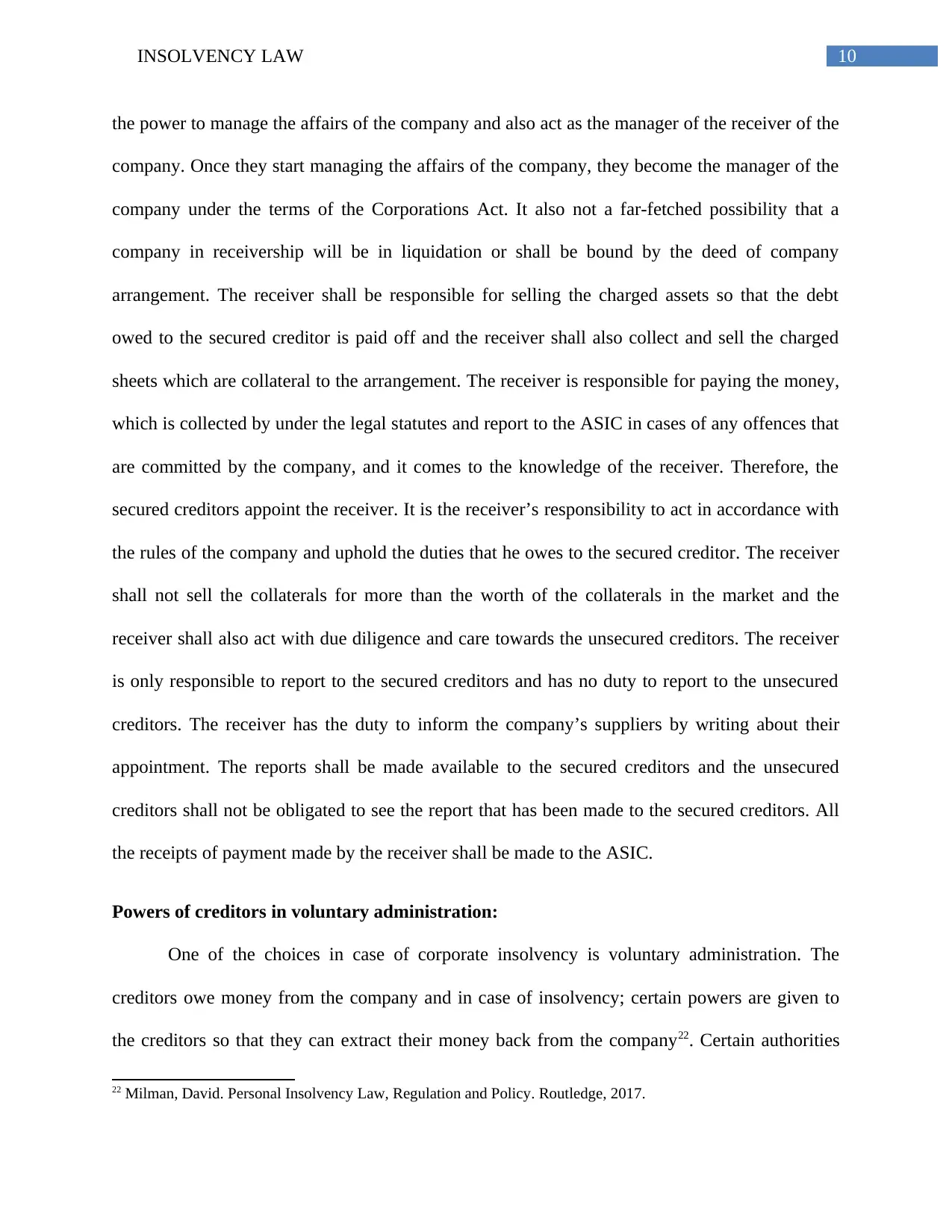
10INSOLVENCY LAW
the power to manage the affairs of the company and also act as the manager of the receiver of the
company. Once they start managing the affairs of the company, they become the manager of the
company under the terms of the Corporations Act. It also not a far-fetched possibility that a
company in receivership will be in liquidation or shall be bound by the deed of company
arrangement. The receiver shall be responsible for selling the charged assets so that the debt
owed to the secured creditor is paid off and the receiver shall also collect and sell the charged
sheets which are collateral to the arrangement. The receiver is responsible for paying the money,
which is collected by under the legal statutes and report to the ASIC in cases of any offences that
are committed by the company, and it comes to the knowledge of the receiver. Therefore, the
secured creditors appoint the receiver. It is the receiver’s responsibility to act in accordance with
the rules of the company and uphold the duties that he owes to the secured creditor. The receiver
shall not sell the collaterals for more than the worth of the collaterals in the market and the
receiver shall also act with due diligence and care towards the unsecured creditors. The receiver
is only responsible to report to the secured creditors and has no duty to report to the unsecured
creditors. The receiver has the duty to inform the company’s suppliers by writing about their
appointment. The reports shall be made available to the secured creditors and the unsecured
creditors shall not be obligated to see the report that has been made to the secured creditors. All
the receipts of payment made by the receiver shall be made to the ASIC.
Powers of creditors in voluntary administration:
One of the choices in case of corporate insolvency is voluntary administration. The
creditors owe money from the company and in case of insolvency; certain powers are given to
the creditors so that they can extract their money back from the company22. Certain authorities
22 Milman, David. Personal Insolvency Law, Regulation and Policy. Routledge, 2017.
the power to manage the affairs of the company and also act as the manager of the receiver of the
company. Once they start managing the affairs of the company, they become the manager of the
company under the terms of the Corporations Act. It also not a far-fetched possibility that a
company in receivership will be in liquidation or shall be bound by the deed of company
arrangement. The receiver shall be responsible for selling the charged assets so that the debt
owed to the secured creditor is paid off and the receiver shall also collect and sell the charged
sheets which are collateral to the arrangement. The receiver is responsible for paying the money,
which is collected by under the legal statutes and report to the ASIC in cases of any offences that
are committed by the company, and it comes to the knowledge of the receiver. Therefore, the
secured creditors appoint the receiver. It is the receiver’s responsibility to act in accordance with
the rules of the company and uphold the duties that he owes to the secured creditor. The receiver
shall not sell the collaterals for more than the worth of the collaterals in the market and the
receiver shall also act with due diligence and care towards the unsecured creditors. The receiver
is only responsible to report to the secured creditors and has no duty to report to the unsecured
creditors. The receiver has the duty to inform the company’s suppliers by writing about their
appointment. The reports shall be made available to the secured creditors and the unsecured
creditors shall not be obligated to see the report that has been made to the secured creditors. All
the receipts of payment made by the receiver shall be made to the ASIC.
Powers of creditors in voluntary administration:
One of the choices in case of corporate insolvency is voluntary administration. The
creditors owe money from the company and in case of insolvency; certain powers are given to
the creditors so that they can extract their money back from the company22. Certain authorities
22 Milman, David. Personal Insolvency Law, Regulation and Policy. Routledge, 2017.
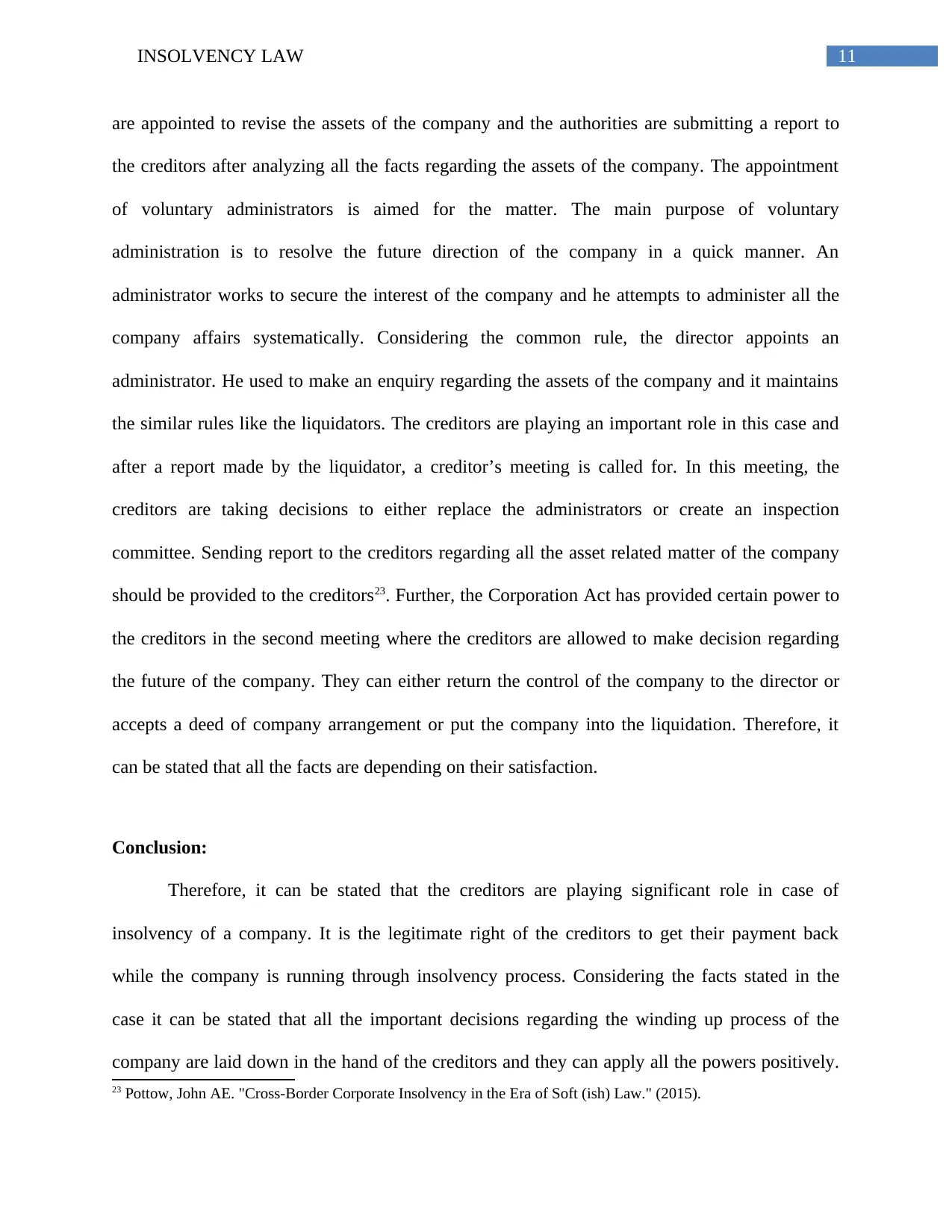
11INSOLVENCY LAW
are appointed to revise the assets of the company and the authorities are submitting a report to
the creditors after analyzing all the facts regarding the assets of the company. The appointment
of voluntary administrators is aimed for the matter. The main purpose of voluntary
administration is to resolve the future direction of the company in a quick manner. An
administrator works to secure the interest of the company and he attempts to administer all the
company affairs systematically. Considering the common rule, the director appoints an
administrator. He used to make an enquiry regarding the assets of the company and it maintains
the similar rules like the liquidators. The creditors are playing an important role in this case and
after a report made by the liquidator, a creditor’s meeting is called for. In this meeting, the
creditors are taking decisions to either replace the administrators or create an inspection
committee. Sending report to the creditors regarding all the asset related matter of the company
should be provided to the creditors23. Further, the Corporation Act has provided certain power to
the creditors in the second meeting where the creditors are allowed to make decision regarding
the future of the company. They can either return the control of the company to the director or
accepts a deed of company arrangement or put the company into the liquidation. Therefore, it
can be stated that all the facts are depending on their satisfaction.
Conclusion:
Therefore, it can be stated that the creditors are playing significant role in case of
insolvency of a company. It is the legitimate right of the creditors to get their payment back
while the company is running through insolvency process. Considering the facts stated in the
case it can be stated that all the important decisions regarding the winding up process of the
company are laid down in the hand of the creditors and they can apply all the powers positively.
23 Pottow, John AE. "Cross-Border Corporate Insolvency in the Era of Soft (ish) Law." (2015).
are appointed to revise the assets of the company and the authorities are submitting a report to
the creditors after analyzing all the facts regarding the assets of the company. The appointment
of voluntary administrators is aimed for the matter. The main purpose of voluntary
administration is to resolve the future direction of the company in a quick manner. An
administrator works to secure the interest of the company and he attempts to administer all the
company affairs systematically. Considering the common rule, the director appoints an
administrator. He used to make an enquiry regarding the assets of the company and it maintains
the similar rules like the liquidators. The creditors are playing an important role in this case and
after a report made by the liquidator, a creditor’s meeting is called for. In this meeting, the
creditors are taking decisions to either replace the administrators or create an inspection
committee. Sending report to the creditors regarding all the asset related matter of the company
should be provided to the creditors23. Further, the Corporation Act has provided certain power to
the creditors in the second meeting where the creditors are allowed to make decision regarding
the future of the company. They can either return the control of the company to the director or
accepts a deed of company arrangement or put the company into the liquidation. Therefore, it
can be stated that all the facts are depending on their satisfaction.
Conclusion:
Therefore, it can be stated that the creditors are playing significant role in case of
insolvency of a company. It is the legitimate right of the creditors to get their payment back
while the company is running through insolvency process. Considering the facts stated in the
case it can be stated that all the important decisions regarding the winding up process of the
company are laid down in the hand of the creditors and they can apply all the powers positively.
23 Pottow, John AE. "Cross-Border Corporate Insolvency in the Era of Soft (ish) Law." (2015).
⊘ This is a preview!⊘
Do you want full access?
Subscribe today to unlock all pages.

Trusted by 1+ million students worldwide
1 out of 16
Related Documents
Your All-in-One AI-Powered Toolkit for Academic Success.
+13062052269
info@desklib.com
Available 24*7 on WhatsApp / Email
![[object Object]](/_next/static/media/star-bottom.7253800d.svg)
Unlock your academic potential
Copyright © 2020–2025 A2Z Services. All Rights Reserved. Developed and managed by ZUCOL.





